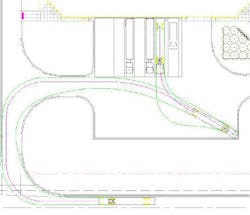Get my drift
Communicating traffic flow designs to clients can be challenging. Despite a lack of formal training, most clients have their own ideas about traffic flow, street and highway design or parking configurations. Often, projects need approval from public officials, city engineers and other design professionals who all have their own ideas to add to the mix. To complicate matters further, projects that affect traffic flow patterns are often open to public review and comment prior to approval by city governments.
With so many parties involved in the project approval process, the consulting engineer is often bombarded with ideas and recommendations that only serve to slow the progress and approval for the project.
Consider project designs with tight spaces, close property lines and building modifications that require unique solutions to allow traffic to maneuver in and out easily—such as loading docks that are accessed through narrow alleys by delivery trucks and tractor-trailers; or loading docks that have tight access in order to use limited land and paved areas efficiently.
In one instance, Finley was given a proposed $22-million design that would limit the amount of space and paved area used for truck traffic and personnel parking. It later became obvious that the space was inappropriate, Finley said, but communicating the problem verbally was unsuccessful. It required a graphic-based form of communication.
Using the software, the computer-aided design operator selected a vehicle size and weight that appears graphically on the screen. The operator then maneuvered the vehicle through the design with the mouse. As the vehicle moved through the design, it left “tracks in the snow,” showing where the wheels had been.
As a result, the developers of the proposed design were able to see the problems. “We have successfully demonstrated design validity using [the software] on more than a dozen recent projects,” Finley said. “Clients have consistently commented that they can understand our design solutions quickly and they have approved designs in shorter time frames than in the past.”
UTI has seen additional benefits by using AutoTURN . Because the software helps clients understand the design solutions easily, project delays have been reduced, and there have been fewer redesign requests from clients.
